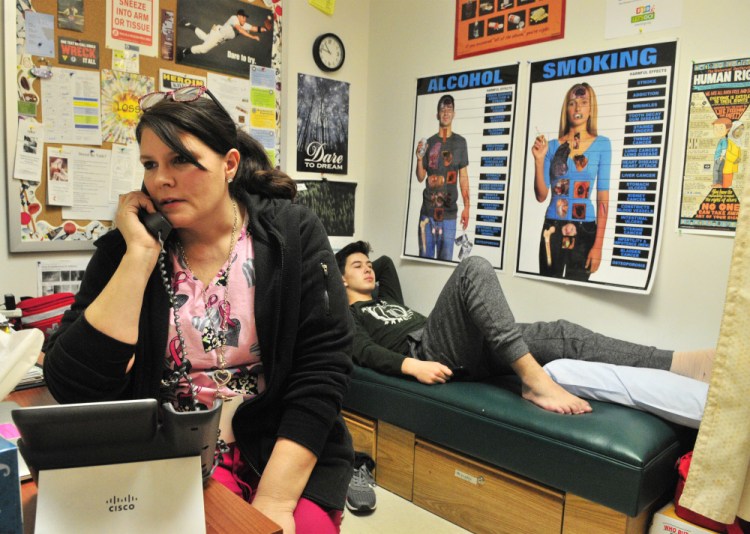WINTHROP — On a recent morning, Rachel Miville was focusing on the health needs of at least eight children.
At one point, Miville received a visit from two JV basketball players at Winthrop High School, a boy with a swollen ankle and a girl with an inflamed toe, who both worried they’d miss their games against Lisbon High School the next day.
While dealing with the basketball players, Miville also assisted two other high-schoolers. The other, a junior, hit her head recently, and Miville gave her a short neurological assessment, asking how she was sleeping, how her balance was, and other questions.
Then Miville, who has worked as a school nurse for 10 years, grabbed a walkie-talkie, threw on her coat, left the building and made the short drive to Winthrop Middle School. One student complained of swollen lymph nodes, another had an ear ache, and a third asked to see her later in the morning. In between talking with students, Miville was communicating with other staff members of the Winthrop School District via text message.
It seemed like a busy morning, but it was a typical one for Miville, the only nurse in a school district of about 900 students. Besides going between the middle and high schools, which are next to each other, “Nurse Rachel” also makes trips to Winthrop Grade School, more than a mile away, and to students’ homes.
“No matter what (school) building I walk in, it’s consistent like that,” she said. “School nurses have this reputation of giving out Tums and putting Band-Aids on, but it’s not like that. I make home visits. I’m often the first in line to catch things. … Do they have adequate food, water, access to heat?”
Given the growing number of health and social problems facing Maine children, Miville and other Winthrop school officials say the district’s nursing services could use even more support in the future to ensure students are healthy and ready to study.
The problems include a rise in children being diagnosed with complicated, chronic conditions such as diabetes and asthma, as well as mental illnesses such as anxiety.
In the Winthrop School District, Miville is currently overseeing 122 students with asthma, 51 with anxiety or depression, 36 with life-threatening allergies, seven with seizure disorders, and six with diabetes, she wrote in an email. She was not immediately able to provide multiple years of data, as the numbers were not saved in one place or in an easily comparable format.
At the same time, the number of low-income Maine children enrolled in federally subsidized health care programs has been dropping, leaving many school nurses on the front line in recognizing health problems. And with the nation’s ongoing opioid epidemic, the rise in substance abuse among adults has also harmed children in various ways.
“The health problems of students are certainly more dramatic than they were 17 years ago when I started this job,” said Ann Bouchard, of Waterville High School, who was recently named school nurse of the year by the Maine Association of School Nurses. “We have kids with chronic health conditions that are physical, but we also have a large number of kids with serious mental health issues, including skyrocketing levels of anxiety.”
MENTAL, PHYSICAL NEEDS
Deborah Hagler, a Brunswick pediatrician who serves as vice president of the Maine chapter of the American Academy of Pediatrics, agreed that mental health and behavioral health problems are growing among children, and said that those ailments can manifest in physical symptoms.
“The data supports that,” she said. “I’m sure the school nurses see that in the form of bellyaches, headaches, students who are tired. We see that more and more.”
When told how many students Miville is responsible for in the Winthrop schools, Hagler added, “It would depend on how many children have complicated medical needs, but I would assume that’s not optimal. That’s a lot of little people for one person to potentially administer and keep track of medications. … You don’t know if a child is using an inhaler the right way, or has the correct insulin dose.”
No recent information was available about the average staffing levels of nurses in Maine school districts.
In 2016, the American Academy of Pediatrics recommended that there be one full-time, registered nurse in every school building – a threshold that school districts like Winthrop don’t meet.
Charles Eichacker can be contacted at 621-5642 or at:
ceichacker@centralmaine.com
Twitter: ceichacke
Send questions/comments to the editors.




Comments are no longer available on this story